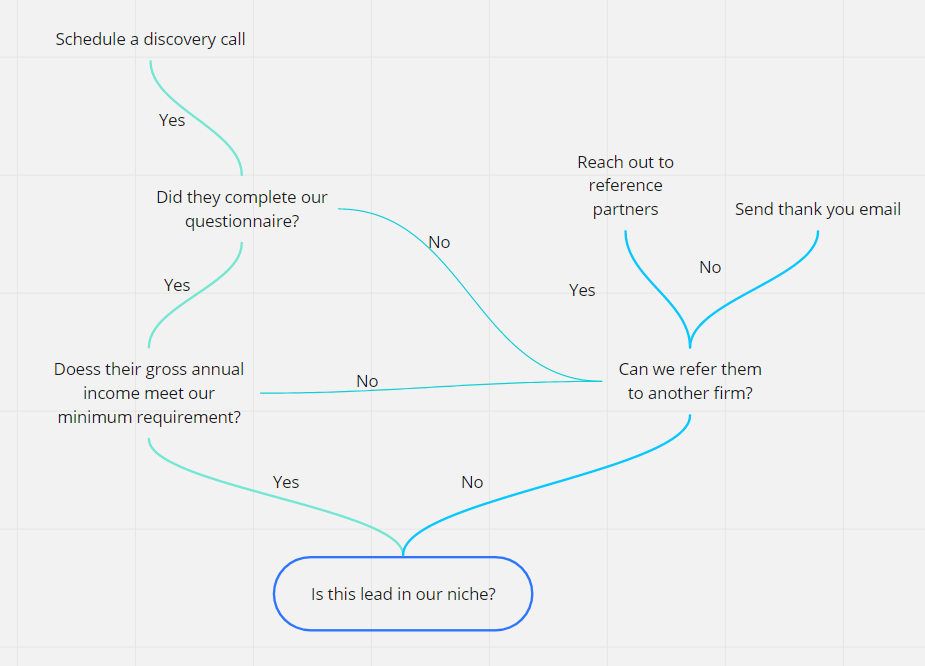How to Use Miro for Creating Decision Trees in Your Bookkeeping Practice
Heads up: I use affiliate links for my fave products. If you click and purchase, I may receive a small commission at no extra cost to you.
Creating decision trees is a topic that, in my opinion, doesn't get the attention it deserves. I know I am all about processes and utilizing a project management system like Asana, but nobody ever talks about the how to handle variable incidents.
Some processes are black and white. Step A leads to Step B, leads to Step C, etc.
But what happens when you have a more conceptual process with variables and nuances? You need a tool to get everything out of your brain and organize it before it goes into your project management system. If you ever plan to outsource some of your work, you'll need to employ a tool that will help your team make decisions and reach the appropriate outcome every time.
There are plenty of options for creating decision trees out there, but I've found the holy grail! The best tool for creating decision trees for your bookkeeping and accounting practice is Miro.
You might have heard me talk about the power of creating decision trees on the Grow Your Firm podcast by Jetpack Workflow! Check out the episode featuring yours truly here.
In this blog, I'm going to outline how I use Miro to create decision trees and how these concepts can translate to your bookkeeping or accounting practice. Read on to learn how to create decision trees for you and your team so they can always reach best conclusion in variable instances.
What are Decision Trees?
A decision tree is a tool that allows you to create a visual representation of how you come to a specific conclusion when a variable situation arises.
Think of your morning routine, this is the process. There are steps that you must take in order to complete the routine, these are the tasks. Sometimes, there will be a variable which requires a decision.
When you are getting dressed in the morning, you likely check the weather or dress based on your plans for the day. Subconsciously, your brain is going through a decision tree to come to a conclusion as to what clothes to wear. The same concept translates to so many parts of your practice, but the ultimate goal is to create this tool that allows a team to make those decisions for you!
How to Use Miro for Creating Decision Trees
As I said before, Miro is absolutely the best software for creating decision trees (and so much more)!
Here's why I like it over other software:
It's free up to three boards (but I HIGHLY recommend upgrading for the use of unlimited boards)
You can create exportable PDFs of your boards
It is super user-friendly
It has a ton of functionalities
Collaborating with your team is a breeze
There are other options out there like Google Draw and even Canva, but I'm telling you that Miro is one hundred percent worth the small monthly fee for the Teams subscription. This is especially true if you are a bookkeeping or accounting practice owner who wants to streamline your systems!
Why You Should Use Miro to Create Decision Trees
Creating decision trees in Miro is essential when you plan to outsource certain tasks to your team. If you need to brain dump your thoughts before actually organizing the steps, you can do so with Miro's infinite whiteboard.
Miro brings your mental decision process into a digital space where you can collaborate with your team, or just save a PDF so everyone has easy access.
Consider creating decision trees for your practice so that your team can follow a specific series of questions and come to a conclusion on their own. This will eliminate the need for them to come to you and constantly ask for approval. Giving your team this level of autonomy increases efficiency and allows you to focus more on scaling your practice.
How to Create Decision Trees Using Miro
You can use decision trees to guide your team (and yourself) towards an answer when a variable situation arises. For example, pre-qualifying a prospective client is a great reason to use a decision tree.
You can create a board with questions that help you vet a lead to see if they are the right fit for you and your practice. Using a decision tree can be a powerful tool in situations like this so you can trust that your team members will come to the same conclusions.
Here is an example of what a decision tree would look like in Miro:
Here are a few examples of situations that might call for a decision tree in your bookkeeping or accounting practice:
When to decide when on auto entry vs. manual entry
When to fire a client
When to decide if something is an asset vs. an expense
When to schedule a month end call
When to enact price increases
Troubleshooting malfunctioning apps
Decisions around expenses vs. COGS categorizations
The Benefits of Using Miro to Create Decision Trees
As you can see, decision trees can have numerous benefits! Implementing this tool in your practice will change the way you are able to outsource your work. If used properly, you can ultimately set up your practice to run on its own and remove yourself from the operations completely!
If this concept resonates with you, I highly suggest joining my group coaching program: Breakthrough for Bookkeepers & Accountants! This program focuses on solidifying the backend of your practice using my proven methods as a former six-figure firm owner.
You can learn more about this program here! (The first ever cohort starts November 1, 2021!)
There will be an entire module in Breakthrough for Bookkeepers & Accountants dedicated to creating World-Class Systems for your practice, INCLUDING lessons on creating decision trees and a tutorial of Miro!
Spots are limited in this group coaching program!


